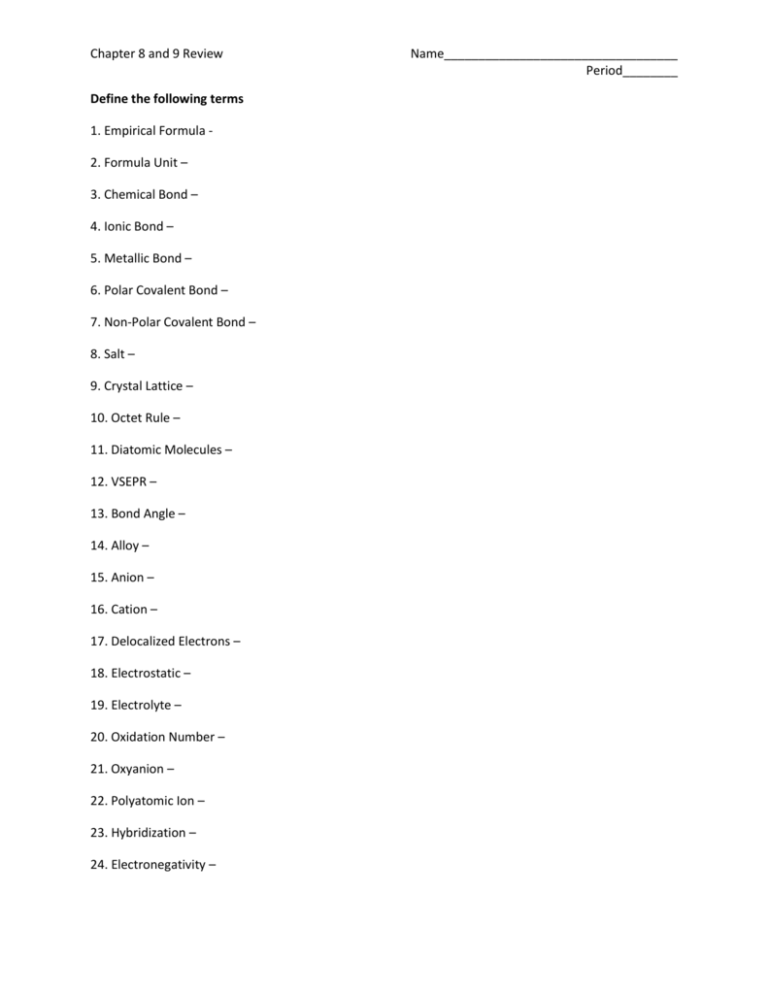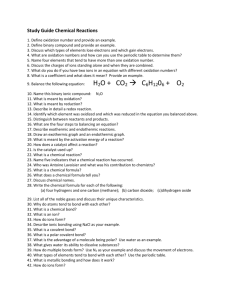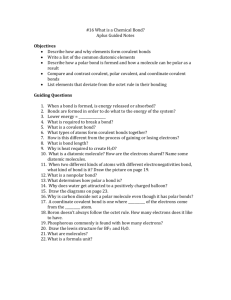File
advertisement

Chapter 8 and 9 Review Define the following terms 1. Empirical Formula 2. Formula Unit – 3. Chemical Bond – 4. Ionic Bond – 5. Metallic Bond – 6. Polar Covalent Bond – 7. Non-Polar Covalent Bond – 8. Salt – 9. Crystal Lattice – 10. Octet Rule – 11. Diatomic Molecules – 12. VSEPR – 13. Bond Angle – 14. Alloy – 15. Anion – 16. Cation – 17. Delocalized Electrons – 18. Electrostatic – 19. Electrolyte – 20. Oxidation Number – 21. Oxyanion – 22. Polyatomic Ion – 23. Hybridization – 24. Electronegativity – Name__________________________________ Period________ Chapter 8 and 9 Review Name__________________________________ Period________ 25. Does a polar bond make a molecule polar? Why or why not? 26. The overall charge of any ionic compound is always ________ 27. What is the formula for calcium bromide? How many Calcium atoms are there? How many Bromine atoms? Which element lost electrons? Which element gained electrons? 28. Write the formula for sodium sulfide and circle the subscript. 29. What is the general electron configuration for a noble gas? 30- 36. Draw the following molecules, identify the shapes, bond angles, hybridization and whether or not the molecule is polar. CBr4 NI3 SiO2 SeO3 OF2 BH3 (Boron is an exception to the octet rule, it only needs 6 valence electrons) BeF2 (Beryllium only needs 4 valence electrons) Chapter 8 and 9 Review Define the following terms 1. Empirical Formula 2. Formula Unit – 3. Chemical Bond – 4. Ionic Bond – 5. Metallic Bond – 6. Polar Covalent Bond – 7. Non-Polar Covalent Bond – 8. Salt – 9. Crystal Lattice – 10. Octet Rule – 11. Diatomic Molecules – 12. VSEPR – 13. Bond Angle – 14. Alloy – 15. Anion – 16. Cation – 17. Delocalized Electrons – 18. Electrostatic – 19. Electrolyte – 20. Oxidation Number – 21. Oxyanion – 22. Polyatomic Ion – 23. Hybridization – 24. Electronegativity – Name__________________________________ Period________ Chapter 8 and 9 Review Name__________________________________ Period________ 25. Does a polar bond make a molecule polar? Why or why not? Only when molecules have an imbalance of polar bonds 26. The overall charge of any ionic compound is always ___zero___ 27. What is the formula for calcium bromide? CaBr2 How many Calcium atoms are there? 1 How many Bromine atoms? 2 Which element lost electrons? Ca (Ca+2) Which element gained electrons? Br (Br-1) 28. Write the formula for sodium sulfide and circle the subscript. Na2S 29. What is the general electron configuration for a noble gas? ? 30- 36. Draw the following molecules, identify the shapes, bond angles, hybridization and whether or not the molecule is polar. CBr4 Br\ Br-C-Br \ Br shape: Tetrahedral angle: 109.5ᵒ polar? yes hybridization: sp3 hybridization: sp3 I–N–I \ I shape: trigonal pyramidal angle: 109.5ᵒ polar? yes hybridization: sp O=Si=O shape: Linear angle: 180.0ᵒ polar? no hybridization: sp3 F–O–F shape: Bent angle: 109.5ᵒ polar? yes NI3 SiO2 SeO3 OF2 BH3 (Boron is an exception to the octet rule, it only needs 6 valence electrons) H-B-H \ H shape: Trigonal planar angle: 120.0ᵒ polar? no hybridization: sp2 BeF2 (Beryllium only needs 4 valence electrons) F-Be-F shape: Linear angle: 180.0ᵒ polar? no hybridization: sp







